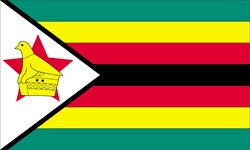
Zimbabwe, a landlocked country in south-central Africa, is only a bit smaller than California. It is bordered by Botswana on the west, Zambia on the north, Mozambique on the east, and South Africa on the south.
The flag, as hoisted on Zimbabwean flag poles in our day, was adopted on April 18, 1980. Zimbabwe gained independence from Britain as Southern Rhodesia in 1965 and then gained independence from Rhodesia as Zimbabwe on April 17, 1980. The Zimbabwe flag incorporates the pan-African colors of red, yellow and green, which were carried by one of the nationalist groups fighting for Zimbabwe's independence. The pan-African colors are used by many African ex-colonies and stand for African independence and unity. It is believed the colors originated from the flag of Ethiopia, the oldest independent nation in Africa. The Black stripe stands for the African majority of the population, red for the blood shed in the liberation struggle, yellow for mineral wealth, green for vegetation and agriculture, and white for peace. The red star inside the white isosceles triangle is a symbol of socialism and national aspiration.
The Zimbabwe bird represents soapstone carving from an ancient African culture, which represents the heritage of the past. The soapstone bird also appears in the crest of the Rhodesian coat of arms, which has not yet been replaced by a new design. Created in 1924, the Rhodesian coat of arms show a lion and two thistles taken from the personal arms of nineteenth century British imperialist Cecil Rhodes for whom the country was then named. A pick representing mining activities and sable antelopes complete the design. The motto translates from the Latin as “May I Be Worthy of the Name.”
Today in Zimbabwe there are still some conflicts arising after since it is in demographic transition. Here is an example from SomaliPress.com “there is growing confusion over whether Zimbabwe can legally export rough diamonds from its military-run Marange fields under the Kimberley Process, the mechanism meant to stop the flow of so-called "blood diamonds." Experts have conflicting views on whether Zimbabwe is complying with Kimberley Process rules.”
As you can tell from this entry, the Zimbabwe flag has quite a bit of history and meaning behind it especially with it’s bloody revolt for independence from Rhodesia and being its own country.


